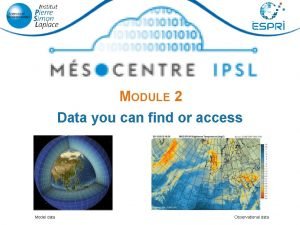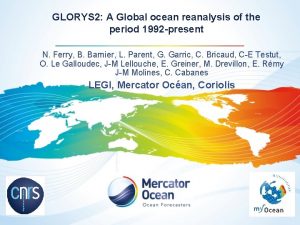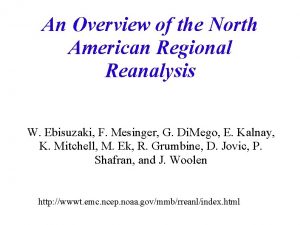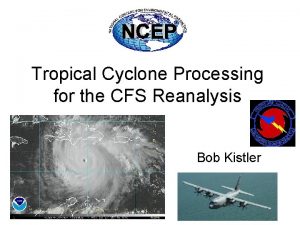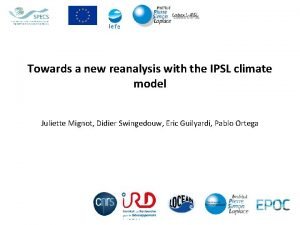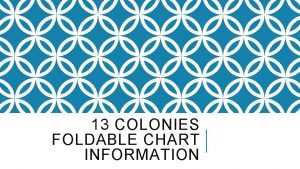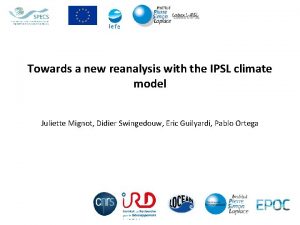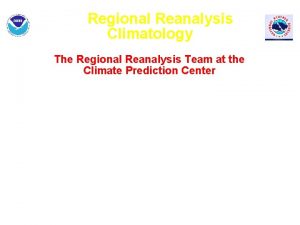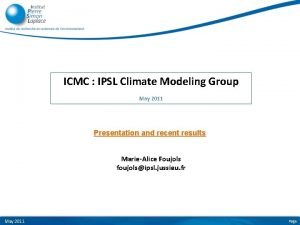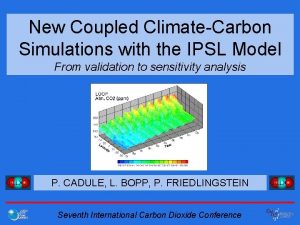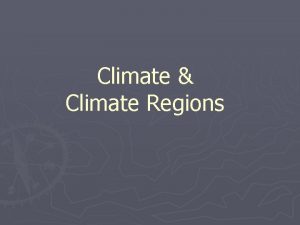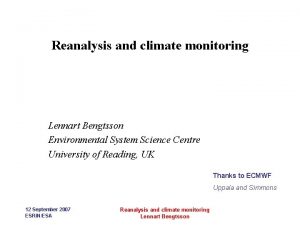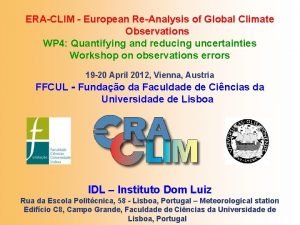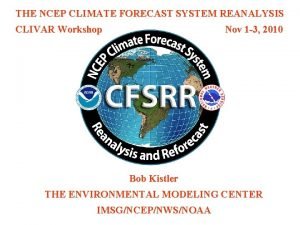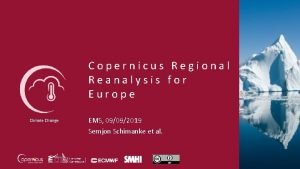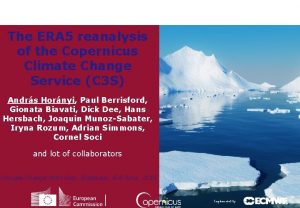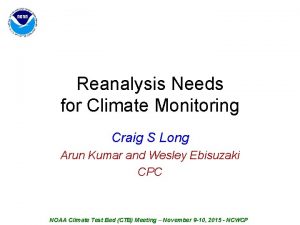Towards a new reanalysis with the IPSL climate




















- Slides: 20

Towards a new reanalysis with the IPSL climate model Juliette Mignot, Didier Swingedouw, Eric Guilyardi, Pablo Ortega

Motivation The large-scale ocean and the Arctic climate Zhang et al 2015 Quadfasel 2005

Motivation Recent measurements: decadal variability or decreasing trend? Ovide section Smeed et al. 2014 Quadfasel 2005 Mercier et al. (2015)

Motivation Longer reconstructions of the N. Atl ocean circulation: oceanic reanalysis § Poorly consistent in terms of oceanic circulation Anomalous intensity of the AMOC circulation at 45°N from 6 reanalysis data sets Western subpolar gyre intensity Mean values (Sv) Karspeck et al 2015 Born et al 2015 4

Motivation Longer reconstructions of the N. Atl ocean circulation: oceanic reanalysis Which data to constrain? • Correlation of the zonally averaged temperature between SODA and ORAS 4 • Even on temperature, ocean reanalysis hardly agree below 300 m Ray et al. 2014 How are reanalysis constructed? • Very complex (sometimes ad-hoc) systems. • May alter the physics of the model and of the reconstruction • Difficult to trace the origins of the biases Zhang et al 2010

First approach to reconstruct the ocean circulation at IPSL • Constrain (nudge) towards SST only • (and only towards anomalies) 1963 -Agung 1982 -El Chichon 1991 -Pinatubo Global SST nudged simulations (4 members) Free historical simulations (4 members) Had. ISST SODA 2. 2. 4 Ray et al. 2014 § Close agreement with observations and reanalysis (independent from the nudging data set) § Spread among members of nudged runs strongly reduced as compared to free historical runs

First approach to reconstruct the ocean circulation at IPSL Density 1000 -2500 m (1013 kg) Convincing agreement with independent reconstructions 6 4 2 0 -2 -4 Density in the Labrador Sea EN 3, Smith and Murphy 2007 Robson et al. 2014 Obs. (Huck et reconstructions Independent Huck et al 2008 Latif et al. 2004 IPSL climate model + SST nudging Swingedouw et al. 2013

Second step to reconstruct the ocean circulation at IPSL: Improving the surface nudging AMOC maximum at 48 N (No Ekman) • Perfect model framework • Nudging SST and SSS + imposing the wind stress Reconstruction sensitive to the initial conditions and fails reproducing the extreme AMOC peak. Ortega et al. 2017 • To improve the representation of AMOC extreme events • To test the sensitivity to the initial AMOC state

Second step to reconstruct the ocean circulation at IPSL: Improving the surface nudging Causes of the AMOC extreme and its misrepresentation AMOC maximum at 48 N (No Ekman) 1000 -2000 m density – South of Iceland The extreme is related to the formation of deep dense waters by convection Ortega et al. 2017

Second step to reconstruct the ocean circulation at IPSL: Improving the surface nudging • Need to reconstruct the precise convection details g 0 = - 40 W/m 2/K is equivalent to a relaxation time of 6 weeks in a layer of h 0=40 m • However, convection happens down to 2000 m & lasts for 2 -3 months g 0 = - 40 W/m 2/K is too weak to enforce this • We introduce a variable g. T, proportional to the mixed layer depth, but keeping the same relaxation time g. T = (g 0 / h 0) • mixed layer depth Ortega et al. 2017

Second step to reconstruct the ocean circulation at IPSL: Improving the surface nudging AMOC 48 N in a new set of Surface. TSWind experiments 15 yrs Adverse initial conditions (15 yrs before peak) Constant g Ortega et al. 2017 AMOC maximum AMOC extreme Any initial state

Second step to reconstruct the ocean circulation at IPSL: Improving the surface nudging AMOC 48 N in a new set of Surface. TSWind experiments 15 yrs Exact initial conditions (15 yrs before peak) Constant g Ortega et al. 2017 AMOC maximum AMOC extreme Any initial state

Second step to reconstruct the ocean circulation at IPSL: Improving the surface nudging AMOC 48 N in a new set of Surface. TSWind experiments 15 yrs Adverse initial conditions (15 yrs before peak) Variable g Ortega et al. 2017 AMOC maximum AMOC extreme Any initial state

Second step to reconstruct the ocean circulation at IPSL: Improving the surface nudging AMOC 48 N in a new set of Surface. TSWind experiments 15 yrs Exact initial conditions (15 yrs before peak) Variable g Ortega et al. 2017 AMOC maximum AMOC extreme Any initial state

Second step to reconstruct the ocean circulation at IPSL: Improving the surface nudging AMOC 48 N in a new set of Surface. TSWind experiments 25 yrs Any initial conditions (25 yrs before peak) Variable g Ortega et al. 2017 AMOC maximum AMOC extreme Any initial state

Second step to reconstruct the ocean circulation at IPSL: Improving the surface nudging The use of a relaxation term proportional to the mixed layer depth contributes decisively to characterize the extreme AMOC events, irrespective of the initial conditions considered.

Future steps to reconstruct the ocean circulation at IPSL: BLUEACTION • Apply the « variable restoring » configuration in historical conditions -> requires salinity data, still very uncertain Subpolar Gyre [56 N-64 N] SSS_ORAS 4 SSS_SODA 224 SSS_Reverdin 2010 Atlantic [30 N-50 N] SSS_ORAS 4 SSS_SODA 224 SSS_Reverdin 2009

Future steps to reconstruct the ocean circulation at IPSL: BLUEACTION • Apply the « variable restoring » configuration in historical conditions -> requires salinity data, still very uncertain • Test constrains of the coupled model by atmospheric winds Global 2 m-temperature Had. CRUT historical free runs SST-nudged runs Wind-nudged runs SST+Wind nudged runs

Future steps to reconstruct the ocean circulation at IPSL: BLUEACTION • Apply the « variable restoring » configuration in historical conditions -> requires salinity data, still very uncertain • Test constrains of the coupled model by atmospheric winds • Compare to reconstructions performed with 3 D-oceanic nudging on the ARGO period -> necessarily much shorter. Relevance for Blue Action WP 2: Develop and analyse the reanalyse WP 3: Test the sensitivity of the reanalysis to additionnal Greenland Ice Sheet melting WP 4: Use this reanalysis as initial conditions and/or validation data set for decadal predictions

 Ciclad ipsl
Ciclad ipsl Glorys reanalysis
Glorys reanalysis North american regional reanalysis
North american regional reanalysis Cfs reanalysis
Cfs reanalysis Reanalysis
Reanalysis Climate change 2014 mitigation of climate change
Climate change 2014 mitigation of climate change New england colonies climate
New england colonies climate New england colonies
New england colonies Hát kết hợp bộ gõ cơ thể
Hát kết hợp bộ gõ cơ thể Lp html
Lp html Bổ thể
Bổ thể Tỉ lệ cơ thể trẻ em
Tỉ lệ cơ thể trẻ em Voi kéo gỗ như thế nào
Voi kéo gỗ như thế nào Tư thế worm breton là gì
Tư thế worm breton là gì Hát lên người ơi
Hát lên người ơi Các môn thể thao bắt đầu bằng tiếng chạy
Các môn thể thao bắt đầu bằng tiếng chạy Thế nào là hệ số cao nhất
Thế nào là hệ số cao nhất Các châu lục và đại dương trên thế giới
Các châu lục và đại dương trên thế giới Công thức tiính động năng
Công thức tiính động năng Trời xanh đây là của chúng ta thể thơ
Trời xanh đây là của chúng ta thể thơ Cách giải mật thư tọa độ
Cách giải mật thư tọa độ
